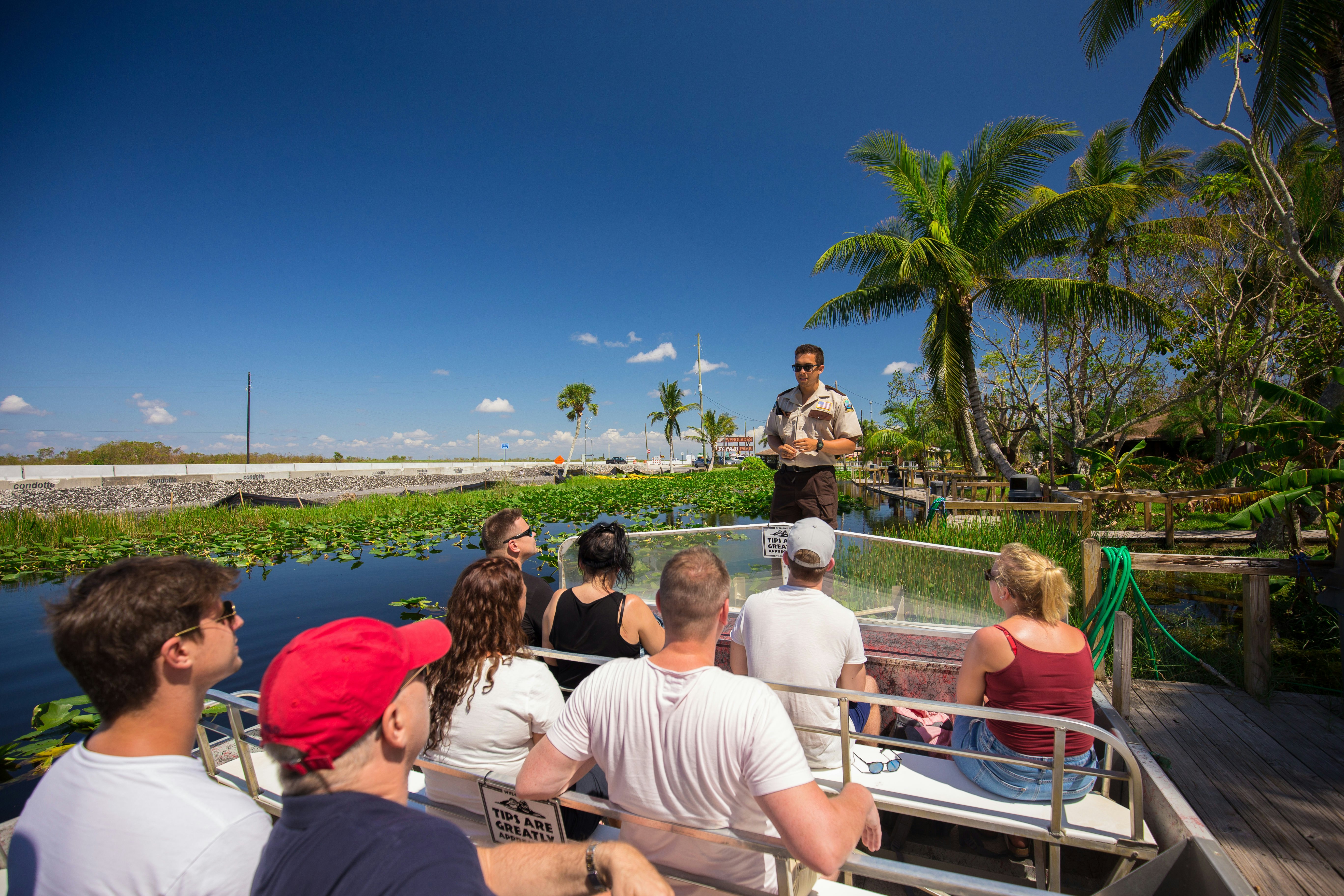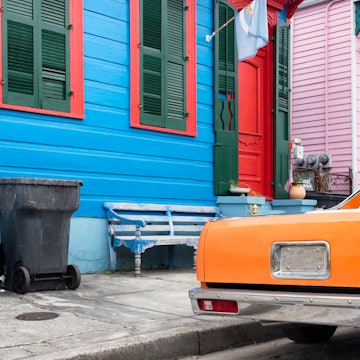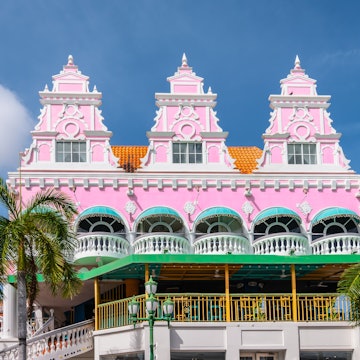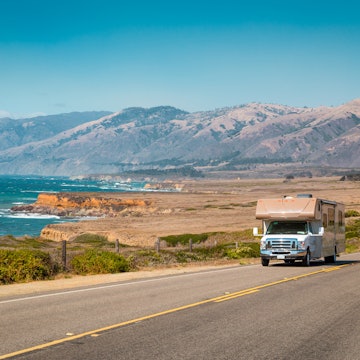

A seaplane at Dry Tortugas National Park in Florida. Shutterstock
Visitors have many options for getting between and around Florida's pristine coastlines, swampy lagoons and big-time cities.
Although the sprawl of the Sunshine State makes it a car-centric place, you can crisscross the state by plane, catch a train along the southwest coast, or Key-hop via water taxi.
Wherever your adventure may take you, here's how to get around Florida.
Arrive in Florida by plane at one of its 131 airports
If you're visiting Florida from somewhere else in the USA (or abroad), there's a good chance you'll be flying in. The state has 131 public airports (24 of them international), with hubs in Orlando, Miami, Fort Lauderdale, West Palm Beach, Tampa and Jacksonville.
Several airlines provide flights within Florida, including American Airlines, United Airlines, Miramar-based Spirit Airlines and Fort Lauderdale–based Silver Airways.
Along with most US airports, major holidays (eg, Thanksgiving and Christmas) can bring major congestion and longer wait times at Florida's airports, particularly as northern residents escape the colder weather.

Taking the train in Florida is a breeze compared to driving
Perhaps surprisingly, Florida has extensive passenger train service. Amtrak has 19 stations in the state, serving three principal routes that generally run north to south.
With 14 total stops, the Silver Meteor route starts in Jacksonville, runs to Orlando in Central Florida and then south along the Atlantic Coast through West Palm Beach and to Miami.
The Silver Star route has 18 Florida stops, also starting in Jacksonville before hitting Orlando, running west to Tampa and Winter Haven and then winding back to the Atlantic Coast via Fort Lauderdale to Miami.
For travelers either starting or ending an East Coast train adventure in Florida, Amtrak's Auto Train is a unique offering. This overnight route between Sanford, FL, and Lorton, VA – with no stops in between – lets you take your car or motorcycle on board. Don't worry: you can relax in the dining and lounge cars rather than having to sit in your auto the entire time.
Also operating within the state is Brightline, the modern and luxurious high-speed passenger rail system that has stops in Orlando, West Palm Beach, Boca Raton, Fort Lauderdale, Aventura and Miami. A ride from Fort Lauderdale to Miami takes 30 minutes, and a one-way trip from West Palm Beach to Miami takes an hour. Amid typically heavy traffic and rush hour in South Florida, this is a stellar option for shaving some time off a trip, with stations conveniently located in the heart of each destination's downtown. A trip from Miami to Orlando takes approximately 3 hours, making trips to Florida theme parks and Orlando International Airport a breeze compared to driving.
Florida has two commuter rail systems. Tri-Rail has 18 stations in South Florida, running from just north of West Palm Beach south to Miami International Airport. Several stations offer local bus routes that connect to their closest downtowns.
SunRail is Orlando's commuter-rail system, with 17 stations running from DeLand south to the Poinciana station in Kissimmee – providing an easy way to explore all that Central Florida has to offer.
Planning tip: Tri-Rail has a stop at Miami International Airport for maximum convenience.

Discover the pleasure of traveling in Florida by boat
Lined with white-sand beaches and turquoise waters, Florida is a boating utopia. Its principal cruise ports are among the busiest in the world, including those in Jacksonville, Cape Canaveral, Tampa, Fort Lauderdale and Miami – all with easy transportation connections to nearby towns.
Cruise liners depart frequently for destinations in the Caribbean, Mexico and beyond, with trips lasting from a weekend to several weeks.
Within Florida, a number of ferry and water-taxi options provide tranquil and often scenic trips. The Yankee Freedom III ferry in Key West is the only public transportation option for accessing remote and beautiful Dry Tortugas National Park, a seven-island park that's 70 miles off the coast of the Florida Keys.
Water taxis are popular in regions with coastal and river terrains. You can hail an aquatic ride with St John's River Taxi & Tours in Jacksonville, the Pirate Water Taxi in Tampa, the Naples Bay Water Shuttle, Fort Lauderdale's Water Taxi and in Destin on the Panhandle.
For a splurge, boat rental and private charter throughout the state also beckon. Be advised that in addition to any hourly or daily rental fees, additional charges for a captain's services, crew, gasoline, overnight dockage and more may apply. You'll want to sort out as many fees as possible up front to avoid any shocks when you're back on land.

Explore Florida by car
Florida's roads run the gamut from State Road A1A – which hugs the Atlantic Ocean from Fernandina Beach all the way down to Key West – to major highways. Several of the state's major interstates have tolls – including the Florida Turnpike (Ocala to Homestead), the stretch of Interstate 75 between Miami and Naples and the Bee Line Express between Orlando and Cape Canaveral. Tolls are collected via radio tag or billed by mail, so if you're renting a car, consider renting a SunPass tag, too, to avoid additional admin fees.
Car rentals are widely available throughout the state to individuals 21 and older. (Those under 25 will have to pay a surcharge.) All car renters in Florida are required to have a valid driver's license from their state or country of residence and may be required to purchase insurance upon arrival.
If you don't want to get behind the wheel, taxis and ride-share companies like Lyft and Uber operate throughout the state.
Shuttles and buses are also an option
Several towns and regions throughout Florida have their own shuttle or trolley systems as well. Notably, Gainesville has an autonomous, self-driving system that shuttles folks along one of its principal streets. Trolleys throughout the Sunshine State include Clearwater's Jolley Trolley, St Petersburg's Beach Trolley and Tallahassee's free StarMetro.
For exploring beyond a single town or region, buses remain a seamless option for those on a budget. In addition to national staple Greyhound, operators like FlixBus and GotoBus offer routes within the state.
Regardless of how you may navigate the state's roads, expect heavier-than-usual congestion from October through April. This period is known as "Snowbird Season," when an influx of folks from colder points settle in for the winter to enjoy Florida's warmer weather.

Accessible transportation in Florida
Florida caters well to those with accessibility needs. Throughout the state, activities and resources – including wheelchairs, vehicles and guides – are widely available. International travelers can purchase a disabled parking pass for $15 to use during any Florida trip.
















